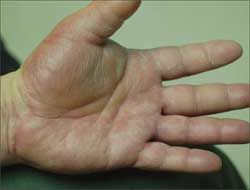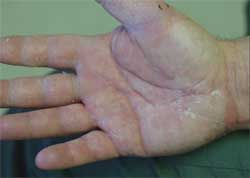- Clinical Technology
- Adult Immunization
- Hepatology
- Pediatric Immunization
- Screening
- Psychiatry
- Allergy
- Women's Health
- Cardiology
- Pediatrics
- Dermatology
- Endocrinology
- Pain Management
- Gastroenterology
- Infectious Disease
- Obesity Medicine
- Rheumatology
- Nephrology
- Neurology
- Pulmonology
Case 1: The patient suspects poison ivy caused this recurrent rash-do you agree?
A 49-year-old man has had intermittent eruptions of itchy blisters on both of his palms for the past 15 years. The lesions heal after 2 to 3 weeks and then occur again after 6 months. He suspects that they are caused by poison ivy, but he is unsure of where he would have been exposed to the plant.
A 49-year-old man has had intermittent eruptions of itchy blisters on both of his palms for the past 15 years. The lesions heal after 2 to 3 weeks and then occur again after 6 months. He suspects that they are caused by poison ivy, but he is unsure of where he would have been exposed to the plant.


The patient is a military pilot. He takes no medications and has no other rashes.
What is your clinical impression?
A. Contact dermatitis.
B. Erythema multiforme.
C. Psoriasis.
D. Lichen planus.
E. Dyshidrosis.
Bonus question: What additional history might be relevant?
Case 1: Erythema multiforme
A skin biopsy confirmed the clinical impression of erythema multiforme, B.
Answer to bonus question: The patient was asked whether he had a history of fever blisters. Although the answer was no, about 80% of persons with herpes simplex virus infection-the most common cause of erythema multiforme-are asymptomatic carriers.1,2 This patient was given a course of daily oral antiviral therapy as a trial in an attempt to prevent the next recurrence.


Contact dermatitis is possible, although the clinical pattern is not consistent with exposure to a contactant. Psoriasis would not remit and recur, and more scaling would be expected. Similarly, lichen planus would not come and go; moreover, the primary lesion is a flat polygonal papule. Dyshidrosis would feature more vesicles on the sides of the fingers as well as the palms.
References:
REFERENCES:
1.
Auquier-Dunant A, Mockenhaupt M, Naldi L, et al; SCAR Study Group. Severe Cutaneous Adverse Reactions. Correlations between clinical patterns and causes of erythema multiforme majus, Stevens-Johnson syndrome, and toxic epidermal necrolysis: results of an international prospective study.
Arch Dermatol.
2002;138:1019-1024.
2.
Viral infections. In: Neville BW, Damm DD, Allen CM, Bouquot JE, eds.
Oral and Maxillofacial Pathology
. 3rd ed. Philadelphia: Elsevier Health Sciences; 2008:240-284.
No Rx Required for COVID-19 Vaccination But ACIP Calls for Better Informed Consent Process
September 22nd 2025The ACIP on September 19 narrowly voted against requiring a prescription to get the shot but urged more detailed discussion of vaccine risks during shared decision making conversations.
